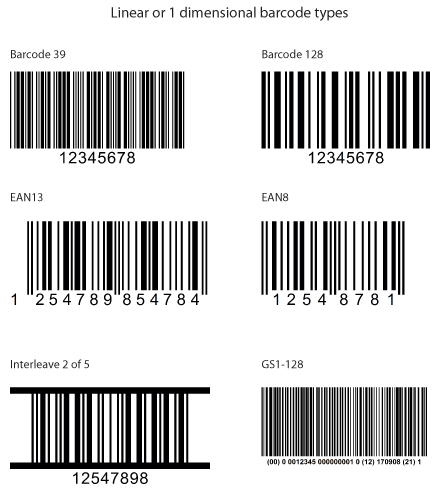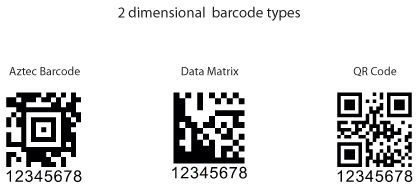Barcode types or symbologies can be confusing with some end users having trouble in identifying the best one to suit their application. Below is a summary of the more popular types of barcode, covering linear or one dimensional and two dimensional types.
Code 39 is a popular means of labelling assets, property and warehouse racking. It is alphanumeric barcode system, which allows a combination of serial numbering with prefix or suffix lettering. It does not have a built in check digit, and has a low data density (meaning that it takes more space). As a consequence of the density, it is not suitable for labelling of small goods. This linear barcode system is commonly ideal for a maximum of 8-10 characters.
Code 128 is another one dimensional barcode type. Again it can provide alphanumeric barcodes. It does have the advantage of providing a check digit for verification, and with it being a high density format, which makes it more space efficient than code 39, allowing longer strings of data. This code is used for product marking, asset tagging, inventory control labels and stickers for warehouse racking applications. GS1 is a subset of code 128 and is used in packaging and shipping, where the first part of the barcode identifier is customer specific.

Interleaved 2 of 5 is a numeric only one dimensional barcode symbology, with digits interleaved to form a single symbol. It is high in data density , but can only handle even numbers of digits. It is used mainly in warehousing and distribution on documents, packages, shipping boxes, pallets and containers. The horizontal bars at the top and bottom of the barcode are to reduce the possibility of misreading on scanning.
EAN 8 and EAN 13 (8 digits and 13 digits respectively) are the recognised system for barcode marking in globally traded retail products, and incorporate details of the manufacturer, product type, pack size etc.. EAN stands for European Article Number (although this has become international), and includes country of origin, manufacturer, product and check digit. At the point of sale these barcodes can present information on price, expiration date and batch production date, as well as supporting stock control and product re-ordering.
QR codes are one of the main two-dimensional or matrix. The QR signifies Quick Response and originated in the automotive industry, and have greater storage capacity and fast readability. The can be numeric or alphanumeric, but have the added advantage for product marketing, as these barcodes can be linked to individual URLs, and can be used in commercial applications for tracking, and for product and service advertising. For applications with a small surface area, there is a Micro QR version. QR codes can contain up to 4296 alphanumeric characters, and has an error correction capability. This can be read by mobile phones.

Data Matrix is another two-dimensional or 2D barcode system. This square patterned alphanumeric barcode is more compact than the QR code, and it is often preferred when marking small items or components, especially in electronic, pharmaceutical and aerospace markets. Once more, it can be read by smart phones. These can contain up to 2335 alphanumeric characters Logos can be included in the centre of the barcode as this does not affect readability, which is contained on the perimeter. Data Matrix has a high storage capacity and correction capability, and are smaller in size allowing them to be generally used in asset marking, and product tracking.
A further 2D coding system is Aztec, which is used widely in the healthcare sector for patient, blood product and specimen identification, and transport applications. It has the potential to offer less space to contain data, because it does not have a quiet zone (a blank space needed by other systems when being scanned). This cannot be read by mobile phones, but only by dimensional imaging devices, thus adding an element of security. Aztec codes offer high levels of error correction to prevent mis-scanning. The size can vary on this system, therefore allowing for huge amounts of data to be stored, but it does not support Kana or Kanji characters, unlike QR codes.
Label Source can produce labels incorporating barcodes to customer design. These are available in a wide range of sizes and a diverse range of materials, including self-adhesive substrates including paper, vinyl, polyester, polypropylene, aluminium foil, tamper evident polyester, destructible vinyl and aluminium.